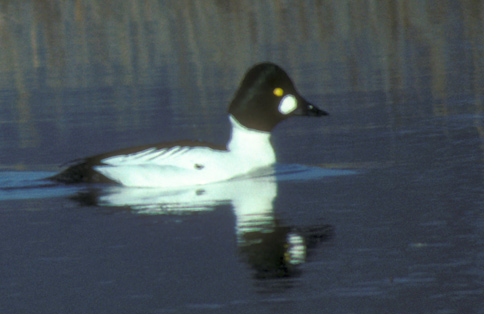Kingdom: Animalia Phylum: Chordata Class: Aves (Birds) Order: Anseriformes Family: Anatidae |
Common Goldeneye (Bucephala clangula) is a diving duck that breeds along lakes, ponds, and rivers in northern boreal forests in Eurasia and northern parts of North America. It is a sparse winter visitor in India. The diet of Common Goldeneye varies with the type of water body. In fresh water, they eat mostly aquatic insects, crayfish, and fish, whereas in salt water, they eat primarily crustaceans and molluscs. Common Goldeneyes float along the surface of shallow water, dive under the water's surface, and then swim after the prey item. Males participate in courtship displays for several months, and monogamous pair bonds are formed. Females that have previously bred will generally return to the same nesting location. Other females will form groups and search for potential nest sites. A female selects a nest cavity in a live or dead tree within a couple kilometers of the shoreline, and then lines it with chips and down. Where nesting sites are limited, females will lay their eggs in other female's nests, resulting in clutches of as many as 30 eggs. Normally a single female will lay a clutch of seven to ten eggs over a period of approximately two weeks. The female incubates the eggs for about a month, and the male abandons the nest just a week or so after she begins incubating. The young all hatch within 12 hours of each other, and they leave the nest just a day or two after hatching. The chicks are highly independent and are able to find their own food when they leave the nest; however, they will remain with their mother for an additional five to six weeks.
|

